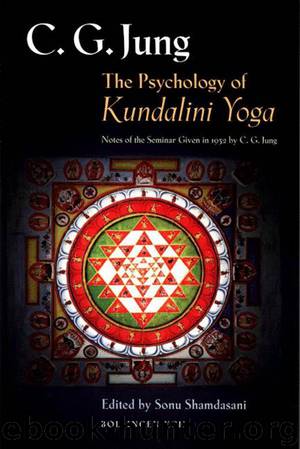The Psychology of Kundalini Yoga by Jung C. G

Author:Jung, C. G. [Jung, C. G.]
Language: eng
Format: mobi
Publisher: Princeton University Press
Published: 1996-02-10T05:00:00+00:00
1 Hauer described the viśuddha cakra as “the cleansed one, or cleansing” (HS, 69).
2 Ibid., 75.
3 Hauer stated of the anāhata cakra: “This heart lotus is the cakra of the fundamental insights into life; it is what we call the creative life in the highest sense” (HS, 90–91).
4 Jung attempted such a bridge in his collaboration with the physicist Wolfgang Pauli in The Interpretation of Nature and the Psyche (Bollingen Series LI, 1955). On this issue, see especially Wolfgang Pauli und C. G. Jung: Ein Briefwechsel 1932–1958, edited by C. A. Meier (Berlin, 1992).
5 Auguste Piccard was a Swiss professor of physics at the University of Brussels. Commencing on 27 May 1931, he ascended for the first time into the stratosphere by means of a special balloon to make scientific observations. His second flight was from the Dübendorf aerodrome near Zurich on 18 August 1932. See his Au dessus des nuages (Above the clouds) (Paris, 1933) and Between Earth and Sky, translated by C. Apcher (London, 1950).
6 Hauer stated that the sahasrāra cakra “is the thousand-spoked or the thousand-petaled cakra” (HS, 69). Eliade noted that “it is here that the final union (unmanī) of Śiva and Śakti, the final goal of tantric sādhana, is realized, and here the kualinī ends its journey after traversing the six cakras. We should note that the sahasrāra no longer belongs to the plane of the body, that it already designates the plane of transcendence—and this explains why writers usually speak of the ‘six’ cakras.” In Mircea Eliade, Yoga: Immortality and Freedom, translated by Willard R. Trask (Bollingen Series LVI; reprint, London, 1989), 243.
7 Jung gave an extended commentary on the symbolic significance of the unicorn in Psychology and Alchemy, in CW, vol. 12, §§518–54.
8 Friedrich Theodor Vischer, Auch Einer, (Stuttgart and Leipzig, 1884).
9 Plato, The Republic, book 7, translated by D. Lee (London, 1955), 514ff.
10 Of the ājñā cakra, Hauer stated: “The god, man power, has disappeared at this stage, but a differentiated woman power is still working, and disappears only in the last cakra. I am not sure whether you will find psychological parallels for that” (HS, 90).
11 For Jung’s analysis of Wotan, in which he does not specifically deal with this motif, see “Wotan” (1936), in CW, vol. 10.
Download
This site does not store any files on its server. We only index and link to content provided by other sites. Please contact the content providers to delete copyright contents if any and email us, we'll remove relevant links or contents immediately.
Tools of Titans by Timothy Ferriss(7813)
Bodyweight Strength Training by Jay Cardiello(7674)
Born to Run: by Christopher McDougall(6894)
Inner Engineering: A Yogi's Guide to Joy by Sadhguru(6440)
Asking the Right Questions: A Guide to Critical Thinking by M. Neil Browne & Stuart M. Keeley(5356)
The Fat Loss Plan by Joe Wicks(4620)
Bodyweight Strength Training Anatomy by Bret Contreras(4466)
Yoga Anatomy by Kaminoff Leslie(4100)
Science and Development of Muscle Hypertrophy by Brad Schoenfeld(3971)
Dynamic Alignment Through Imagery by Eric Franklin(3919)
ACSM's Complete Guide to Fitness & Health by ACSM(3824)
The Four-Pack Revolution by Chael Sonnen & Ryan Parsons(3793)
Exercise Technique Manual for Resistance Training by National Strength & Conditioning Association(3786)
Bodyweight Strength Training: 12 Weeks to Build Muscle and Burn Fat by Jay Cardiello(3779)
Yoga Anatomy by Leslie Kaminoff & Amy Matthews(3738)
The Ultimate Bodybuilding Cookbook by Kendall Lou Schmidt(3707)
Yoga Therapy by Mark Stephens(3571)
Nutrition for Sport, Exercise, and Health by Spano Marie & Kruskall Laura & Thomas D. Travis(3556)
Nutrition for Sport, Exercise, and Health by Marie Spano & Laura Kruskall & D. Travis Thomas(3547)
